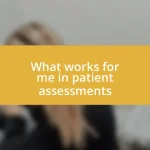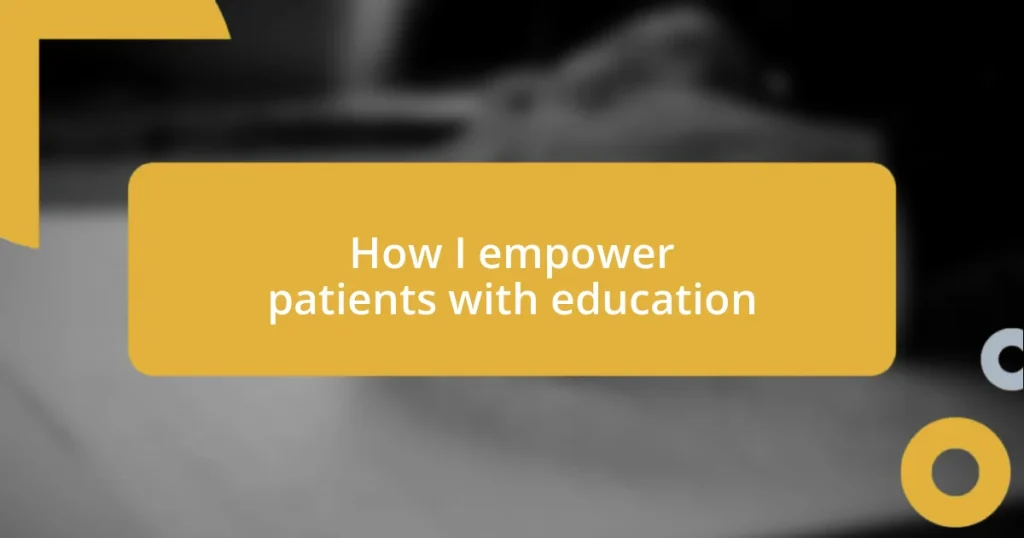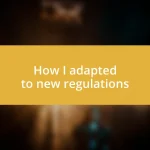Key takeaways:
- Effective patient education involves breaking down complex medical information into understandable language, fostering emotional support, and empowering patients in their health journeys.
- Tailoring educational approaches by assessing prior knowledge, emotional barriers, and cultural backgrounds enhances patient engagement and understanding.
- Creating a supportive learning environment, incorporating interactive strategies, and utilizing technology can significantly improve patient education outcomes and relationships with healthcare providers.
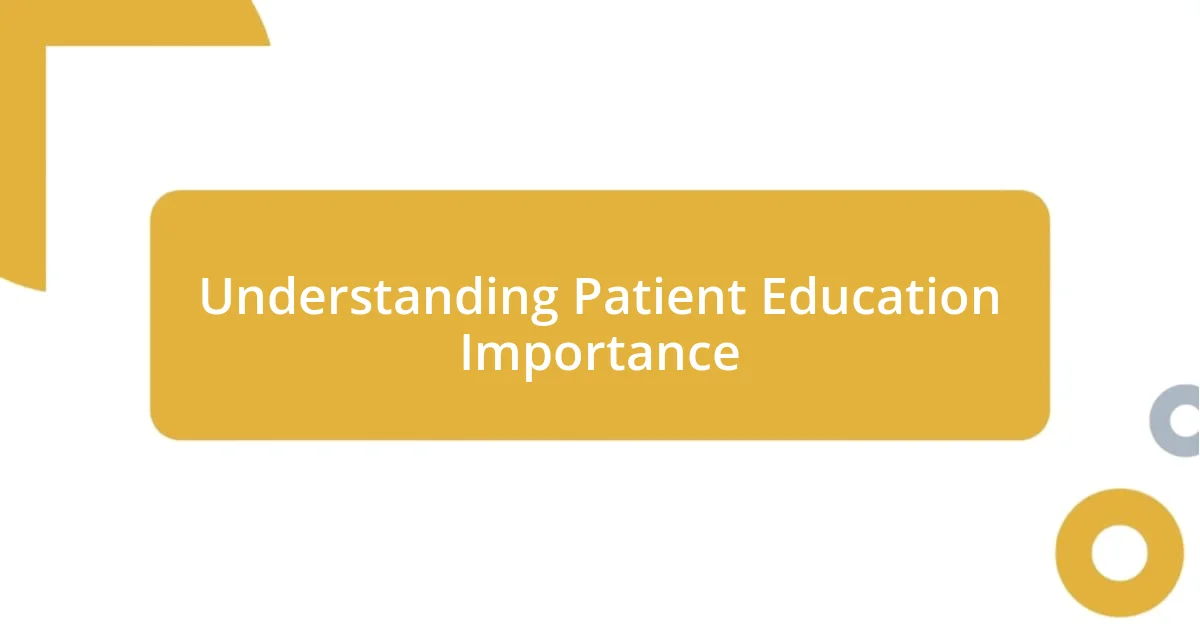
Understanding Patient Education Importance
Patient education is more than just handing out brochures; it’s about fostering comprehension. I remember a time when a patient of mine, overwhelmed with medical jargon, finally grasped their condition during a simple conversation. Seeing the relief on their face was a powerful reminder of how crucial it is to break down complex information into understandable language.
Have you ever tried to navigate a complicated healthcare decision without guidance? It’s daunting. When patients are well-informed, they feel more empowered to participate in their treatment. This collaboration not only enhances their knowledge but can also lead to better health outcomes. I’ve witnessed patients who took proactive steps in their care simply because they understood their options.
Moreover, the emotional aspect of education cannot be overstated. Patients often feel vulnerable and scared when facing health challenges. I’ve seen firsthand how clear, compassionate education can transform that fear into confidence, allowing individuals to take charge of their health journey. It’s this very empowerment that strengthens the patient-provider relationship, fostering trust and encouraging open communication.
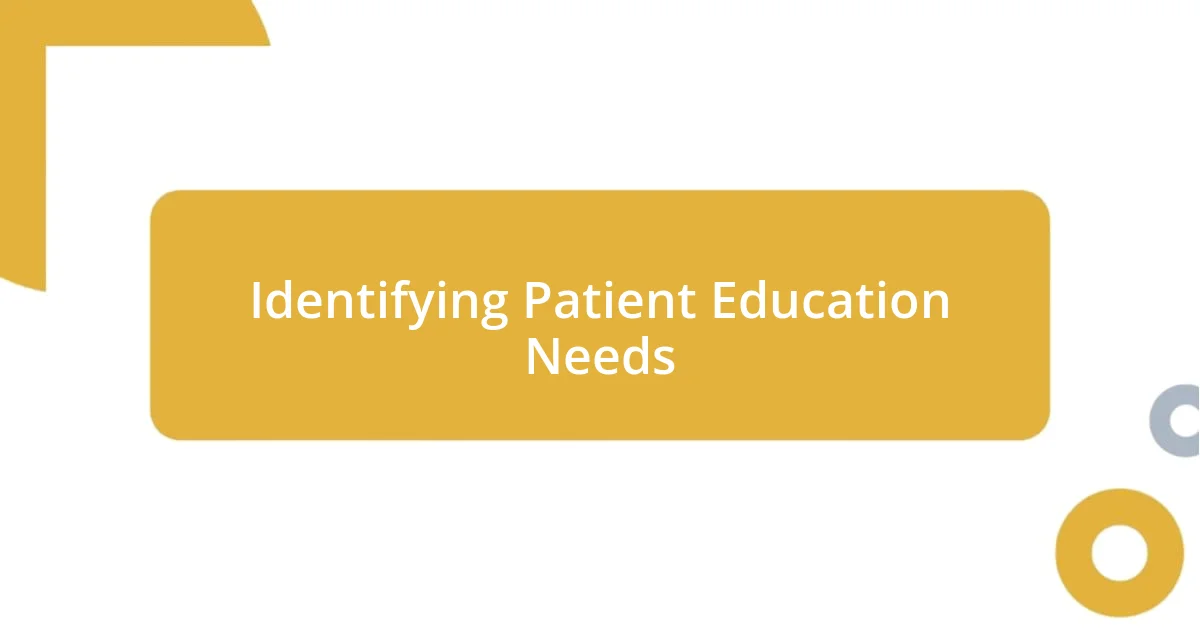
Identifying Patient Education Needs
Identifying patient education needs starts with active listening. In my experience, I’ve found that every patient comes with their own story, and understanding where they’re coming from is key. For instance, one patient shared their anxiety about an impending surgery. This conversation revealed not just their lack of information but also their emotional concerns, which needed to be addressed before they could focus on learning the medical details.
To effectively identify these educational needs, I recommend considering the following approaches:
- Assess Prior Knowledge: Ask open-ended questions to gauge what the patient already knows.
- Evaluate Emotional Barriers: Recognize any fears or anxieties that may hinder their understanding.
- Consider Cultural Background: Be aware of cultural factors that might influence their perceptions of health and education.
- Utilize Teachable Moments: Look for opportunities during consultations to introduce essential information.
By being attuned to these elements, we can create a tailored educational approach that resonates with each patient, making their journey toward understanding more meaningful and effective.
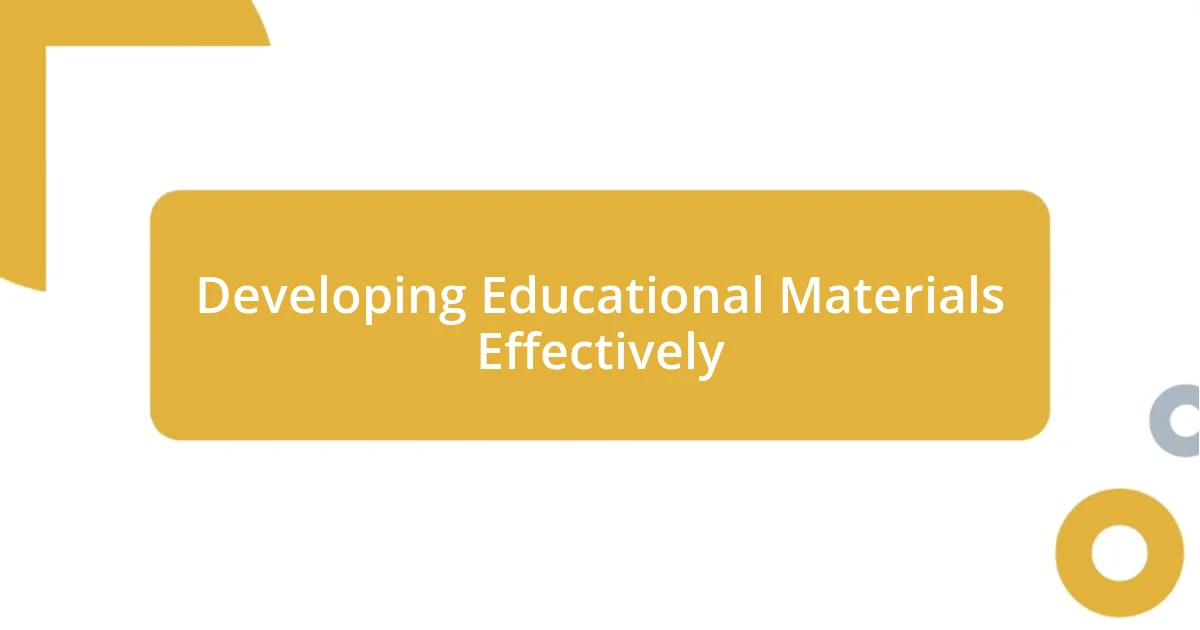
Developing Educational Materials Effectively
When developing educational materials, clarity is essential. I recall a time when I designed a handout on diabetes management. By using straightforward language and appealing visuals, I noticed patients were more likely to read and retain the information. I think about how many times I’ve seen patients leave with a pamphlet in hand, only to never look at it again. The key is to create engaging content that speaks directly to their needs and questions.
I also find it crucial to incorporate various learning styles into the materials. Not everyone absorbs information the same way; some prefer visual aids, while others benefit from written descriptions or interactive tools. For example, I developed a short video that explained medication instructions. Patients responded positively, often recalling details they struggled to understand from a text-based format alone. Each patient response reinforces my belief that diverse educational tools enhance understanding and retention.
Lastly, I encourage feedback on these educational materials. After a recent workshop, I asked participants to evaluate the handouts and presentation style. Their insights led to unexpected improvements, such as the inclusion of more real-life scenarios. It was a humbling experience for me, realizing that co-creating materials with patients can lead to more impactful resources.
| Factors | Considerations |
|---|---|
| Language | Use clear, simple terms; avoid jargon. |
| Visuals | Incorporate images, infographics, and videos. |
| Learning Styles | Address various styles; allow for flexibility (e.g., visual, auditory, kinesthetic). |
| Feedback | Encourage patient input to improve materials continuously. |
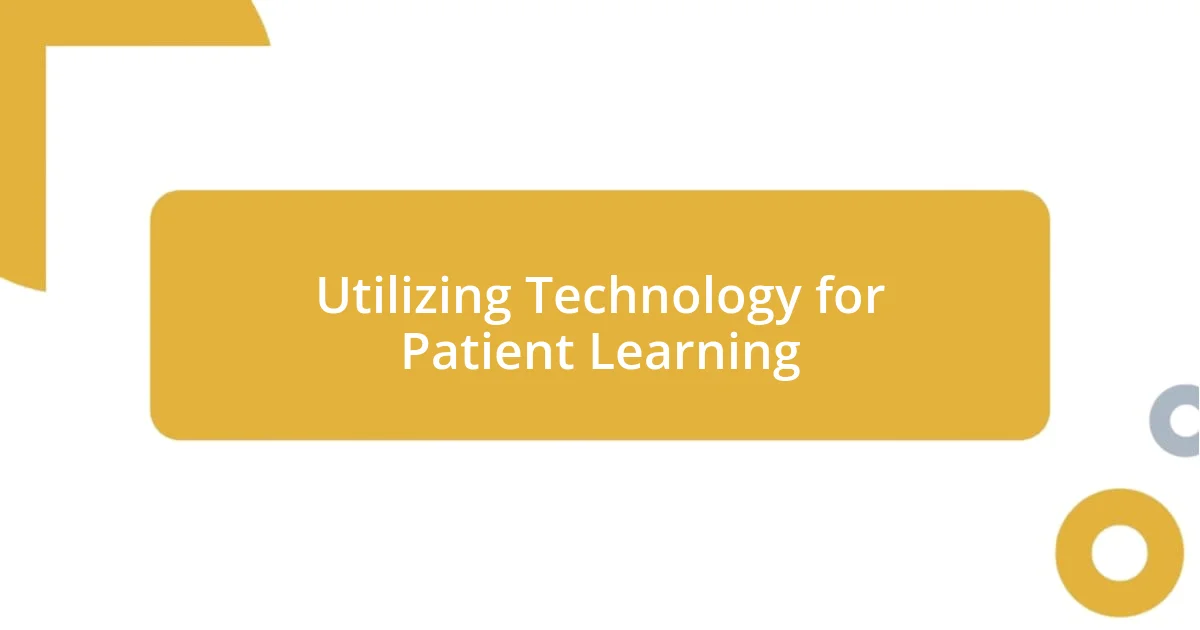
Utilizing Technology for Patient Learning
Technology plays a huge role in enhancing patient learning, and from my experience, it’s a game-changer. For instance, during a consultation, I introduced a patient to a health app designed for tracking symptoms and medication schedules. Watching their eyes light up as they explored the app made me realize how tech can turn complex information into something interactive and approachable.
I’ve also seen the impact of telehealth on patient education. Recently, I had a follow-up video appointment with a patient who was hesitant to engage in a traditional setting. It was fascinating to see how the comfort of their home made them more open to discussing their treatment plan. Does technology not create a bridge for communication that makes learning feel less intimidating? I truly believe that digital tools not only empower patients—they can transform their experience.
Moreover, I often recommend online resources that foster self-education. I remember a time when I guided a patient to a reputable website to explore post-operative care. The relief on their face was palpable when they found answers to questions they didn’t even know they had. It’s moments like these that reaffirm my commitment to leveraging technology as a tool for patient learning—because when patients feel equipped with knowledge, they regain control over their health journeys.
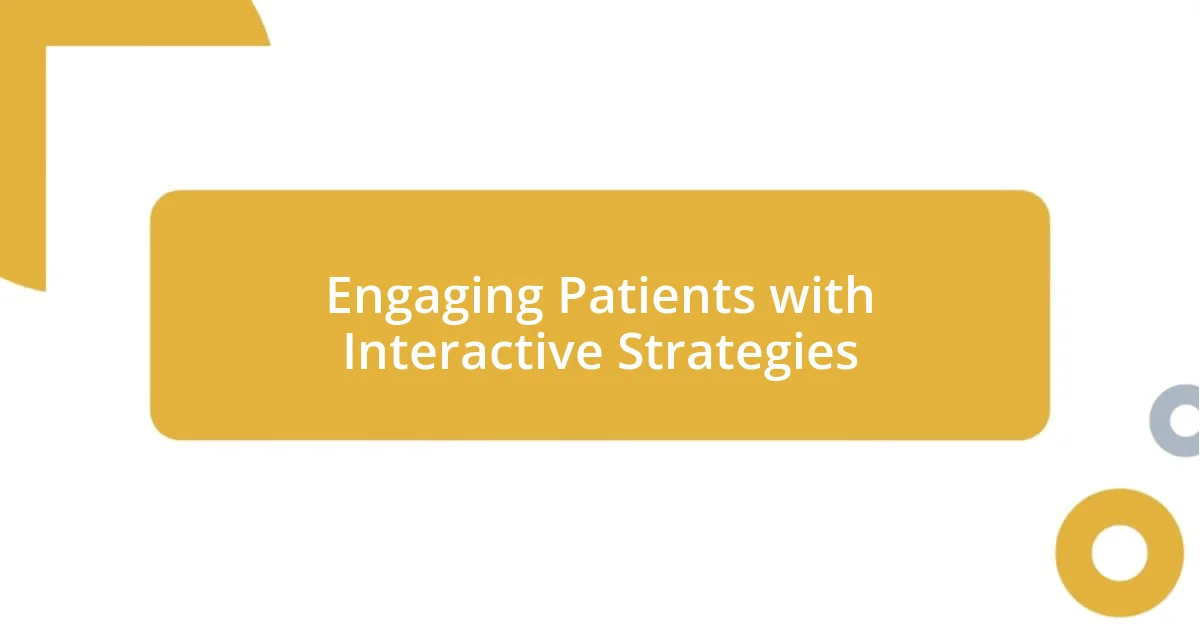
Engaging Patients with Interactive Strategies
Engaging patients through interactive strategies has been a vital component of my approach. I once conducted a workshop where I facilitated a role-playing exercise focused on communicating health concerns. The energy in the room was electrifying! Patients were animatedly discussing their scenarios, and I saw how empowered they felt when they had an opportunity to practice the conversations they were often hesitant to have. Isn’t it incredible how stepping into someone else’s shoes can enhance empathy and clarity in communication?
Another method I’ve found effective is incorporating real-life case studies in educational sessions. Taking generic medical instructions and weaving them into relatable stories allows patients to envision their paths to health. I remember a session where I shared a patient’s journey battling hypertension, including his struggles and victories. Participants leaned in, curious and engaged, as they connected his experiences to their own. Isn’t that what we want? Patients who feel understood and motivated to take charge of their health?
Finally, I never underestimate the impact of gamification in learning. Recently, I introduced a health quiz game in a group setting. The competitive spirit brought laughter, and I loved seeing the participants light up when they answered questions correctly. Not only did they learn, but they bonded over the experience. I often think back to that moment and wonder—how can we make learning about health even more enjoyable and participatory? The answer often lies in embracing creativity in our educational efforts.
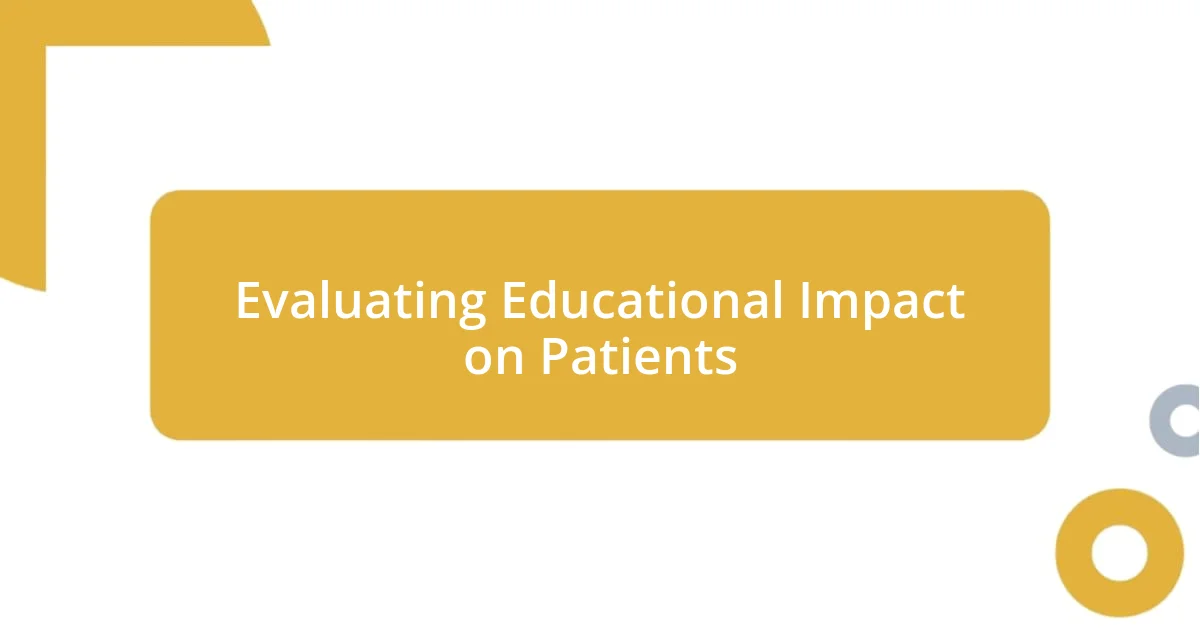
Evaluating Educational Impact on Patients
Evaluating the educational impact on patients involves more than just measuring knowledge retention; it’s about observing tangible changes in their health behaviors. I remember a time when I implemented a follow-up survey after an education session on diabetes management. To my delight, many patients reported not only improved understanding but also significant changes in their dietary habits. It struck me that this transformation was a testament to how well-structured education can lead to real-life results.
From my perspective, integrating feedback is crucial in assessing educational impact. During a recent workshop, I encouraged participants to share their takeaways and any challenges they faced in applying what they learned. Their responses varied, but a common theme emerged: they appreciated understanding the ‘why’ behind their treatment decisions. This insight underscored the importance of tailoring education to meet individual needs, which can vastly improve patient outcomes. It’s not just about presenting information; it’s about fostering understanding and personal relevance.
I’ve also utilized informal check-ins to gauge ongoing learning. After one particularly insightful group session, I sent follow-up texts to see how patients were integrating their new knowledge. One patient shared that they felt more confident discussing their medications with their family, which truly warmed my heart. Isn’t it rewarding to witness patients not only grasp concepts but also share that knowledge with their support systems? This ripple effect of education emphasizes the profound impact it can have on patient empowerment.
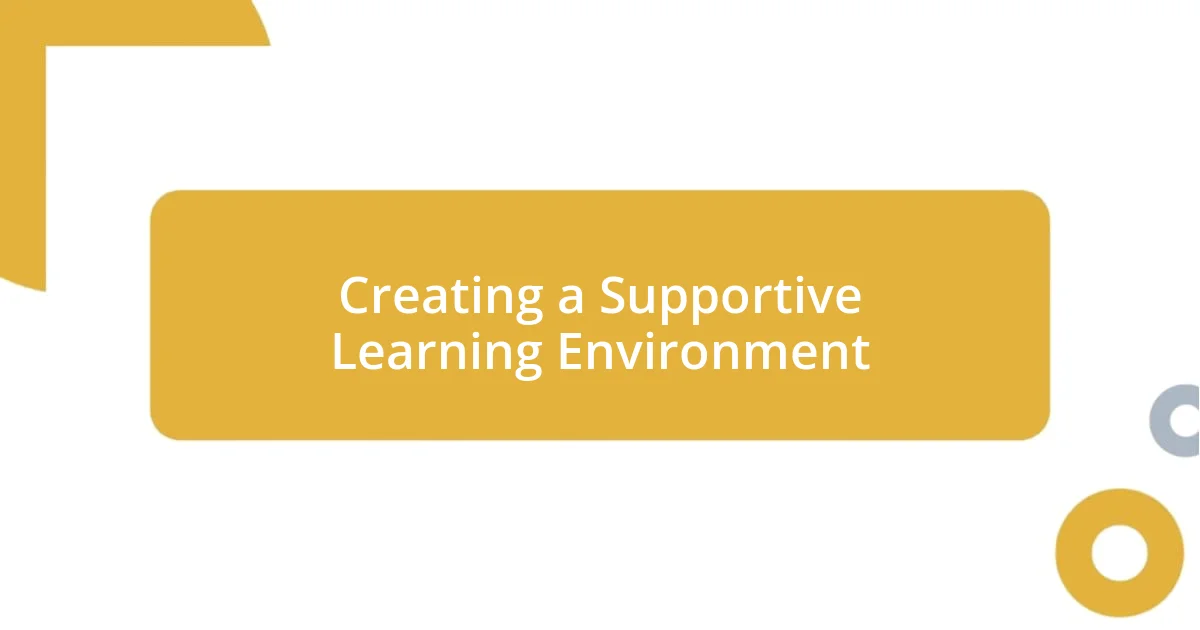
Creating a Supportive Learning Environment
Creating a supportive learning environment truly begins with establishing trust and safety between the educator and the patients. I recall a session where I encouraged patients to express their thoughts and feelings, no matter how trivial they may have seemed. The moment one participant shared their fears about medication side effects, I noticed a wave of relief among others who felt the same but hadn’t voiced it. Isn’t it fascinating how vulnerability can break down barriers and foster connection in learning?
In my experience, incorporating comfortable spaces for dialogue can make a noticeable difference. During one of my workshops, I rearranged seating to create small circles rather than rigid rows. This simple change invited open conversations and allowed participants to share without the pressure of a larger audience. I remember one individual, usually quiet, enthusiastically discussed their strategy for managing stress, igniting a wonderful exchange of ideas. It reminded me that sometimes, the best learning happens in a relaxed, informal setting.
In addition to physical space, I advocate for tailored resources that cater to individual learning styles. I once had a patient who thrived on visual aids but felt lost in traditional lecture formats. By incorporating vibrant infographics and handouts in our sessions, I transformed her experience. She expressed how much easier it was to grasp complex topics when they were presented visually. I couldn’t help but wonder—how many other patients share that same sentiment, yearning for information presented in a way that resonates with them? Each person’s learning journey is unique, and it’s our responsibility to nurture that diversity within our educational approach.

